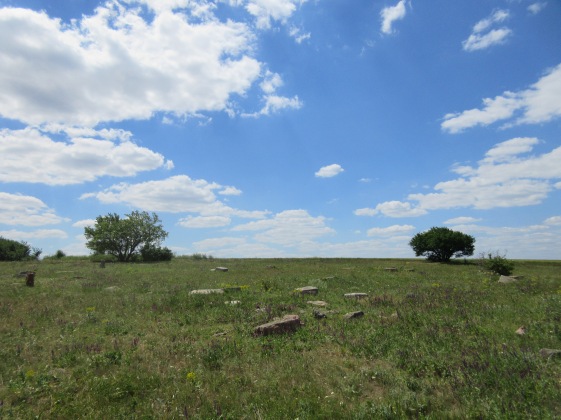
I walked on holy ground last week. Holy ground for me. It is the ground my great-grandparents Srul Shulimovich Minsky and Rivka Minsky walked on for years. The ground they lived on. The ground they were likely born and raised on (I’m still hoping to find archival documents confirming this). The ground that possibly generations of Minsky’s before them live on and are buried in.
I left Odessa four weeks ago to continue on with the journey. After a brief stay with some couchsurfing hosts in a village just outside of Uman and then in Uman itself to celebrate Shavuot and Shabbat with the Breslov Chassidic Pilgrims from around the world, I ventured on to the village my great-grandparents Srul and Rivka Minsky moved to Odessa from. Its current name is Yosypivka, but in my great-grandparents time it was called Yuzefpol.
Before I began this journey, I had never heard of Yuzefpol. I didn’t know where my great-grandparents came from, let alone what my great-grandmother’s name from my father’s side was. I found my grandmother Dina Minsky’s birth record in the Odessa archives. The record revealed my great-grandmother’s name, my great-great-grandfather’s name, and that they were from the village of Yuzefpol. Through further digging and the help of local genealogists, I was able to trace the former Yuzefpol to it’s new name of Yosypivka, a small village in the Vilshanka region of the Kirovograd oblast of Ukraine.
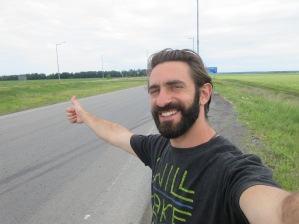
Without knowing anyone there, where I was going to stay (there are no hotels and no people registered on couchsurfing in Yosypivka), or if there was anyone who could tell me anything about the old Jewish shtetl there, I hitch-hiked my way over from Uman to Yuzefpol (there were no direct buses or convenient bus transfers). A series of friendly drivers, out of a sense of altruism or simply desire for company and conversation during a long journey of their own, helped me get to the very rural village in the heart of the country.
I was dropped off a couple kilometers outside, at the beginning of the dirt road leading to the village. With my big backpackers rucksack shouting “outsider,” I headed in. As I walked what was, for the length of those two kilometers, a road deserted of people, I greeted the land. I thanked my ancestors, whom I asked for protection on the long road over. I thanked them for bringing me here as the village came into view in the subtle valley I was heading towards.
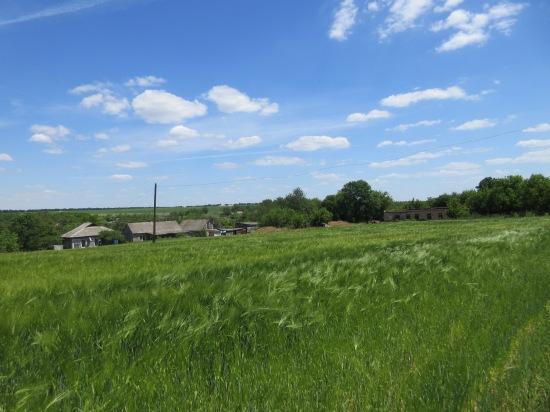
I was finally looking upon with my own eyes the place I had been imagining in my mind the past several months since learning of it. I felt a juxtaposed sense of being an outsider in a strange new land and at the same time being an old acquaintance of this place. My ancestors were fed by this land. Literal molecules that came from the soil of this land became the food, that became the cells, that became the sperm and eggs, that became my grandparents, that became my parents, that became me. Part of me is an old acquaintance. A part of me is this land.
Grounding in this sense and knowing, I walked into the mystery of what this land has become and who is on it now. I passed a few quiet houses, built in traditional Ukrainian village style cob. A bit further down the road, a woman was working in her garden (every house has a big one… or five…). I asked her, in Russian, where I could find the village council administrative office. She replied in Ukrainian. After I explained that I don’t speak Ukrainian, she switched tongues and told me how to find the office.
I turned onto the main street and walked into the center of town, receiving curious glances from people not used to seeing outsiders in their village. I got to the council administrative office to find it closed. I was hoping to see if they had any archival documents that could reveal further information about my ancestors who lived there. In addition to seeking the birth records of my great-grandparents, I’m trying to find the birth records of their two sons, my grandmother’s older brothers with whom she lost contact after they moved to the U.S. (shortly after the Russian Revolution). My father doesn’t know their names. I’ve got a lead on who one of them might have been. Assuming they have descendants, I have long lost relatives somewhere out there. If I can confirm who my grandmother’s brothers were, that will bring me closer to finding our relatives.
I walked into a small store next to the village council office and introduced myself to the woman working there. I explained who I was and what I was doing there, and asked her if the council office was closed for the day. She replied that it was and it wouldn’t be open again until Monday. It was Friday afternoon. I had hoped to get to Yuzefpol earlier in the day, but getting there took longer than expected. I decided to hunker down there for the weekend. I asked the woman, whose name I learned is Lesya, where I could set up my tent for the weekend. She said I could set it up by the lake near the center of town, but before that she would take me to meet her neighbor, the former head of the village council, who might be able to help me find some of the information I’m seeking. She closed up the store (there were still two more working hours of the day) and took me over to her neighbor’s place.
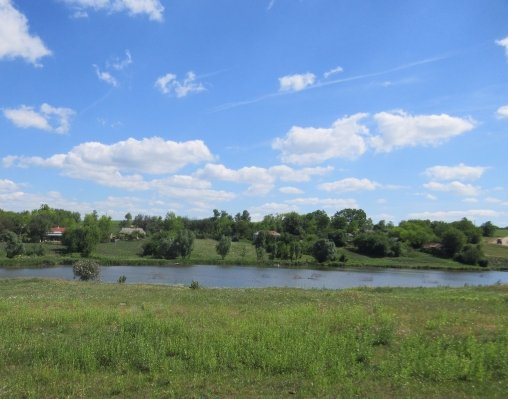
Lake near the village center
An hour later, I had a date scheduled for the next morning with the former head of the village council, Valentina. She had generously offered to give me a tour of the village, in particular the old Jewish quarter, a.k.a. the shtetl, and show me as much as she knows of the Jewish history there. Within this time, Lesya had made arrangements for me to stay with her eldest son on the other side of town, instead of in my tent by the lake, which Valentina and Lesya agreed wasn’t necessarily the safest option due to the handful of alcoholics who may walk around the lake at night. I was flooded with gratitude for the kindness and care these strangers were showering me with. I thanked my ancestors for guiding me to those I needed to find. Within an hour of arriving, I had a tour scheduled of my great-grandparents’ old shtetl and a bed arranged for me to sleep in.
Lesya took me to relax at her home across the street until her eldest son, Vassily, got off work. She introduced me to her younger son, Roma, who just got home from high school. Lesya then went off to reopen the store for its last hour of operation for the day while Roma and I sat down for tea and got to chatting. Lesya returned an hour later and Vassily arrived shortly after with a bucket-full of carp he caught in the lake earlier that day. Lesya fried them up with potatoes that came from their garden, threw together a salad also from their garden, and we sat down to a hearty, home-grown, home-cooked Ukrainian meal. After dinner, Vassily took me to his place and, despite my insistence otherwise, he set me up in his room and he took the couch in the living room. This was Ukrainian village hospitality: take in the stranger and care for them like family.
I met Valentina at her place early the next morning and we set off for our excursion. We headed along the main street, which runs parallel to the river the village was settled along. Contrary to what many warned me regarding Ukrainians offering a stranger help, Valentina wasn’t expecting any money. She was doing this out of the kindness of her heart. She’s a quick-thinking and quick-talking woman with a powerful presence, an infectious laugh, and a big heart.
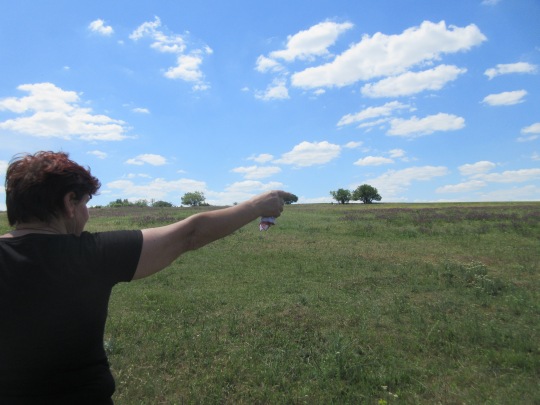
We came to an intersection that Valentina explained was the beginning of the old Jewish neighborhood of the village, the shtetl. The park in front of us, she explained, use to be the bustling Jewish marketplace. We walked up a street with houses spaced widely apart. She said that before the war (WWII), the street was packed and houses were right next to each other. The village’s current population is just over 500 people, according to Valentina. In 1897, the Jewish population was 872 people (36% of the total population), and in 1939 the Jewish population reached 1041, before the Nazis wiped nearly all of them out.
She showed me the one house that is still standing, having been renovated, from the era in which Jews lived in the village. All the other houses that were in the old shtetl were in disrepair and replaced with new homes, barns, and family farms. We passed by the spot where the old synagogue was. Now someone’s house and farm stands in its place. I pictured the old synagogue on the little hill where the house is, and imagined the old shtetl Jews gathering in and around it. My father heard from my aunt, who heard from my grandmother that my great-grandfather Srul Minsky, was a rabbi. I wondered if he led the congregation there in that old synagogue, or if his father, whose name I learned was Shulim, led them (rabbis tend to run in the family).
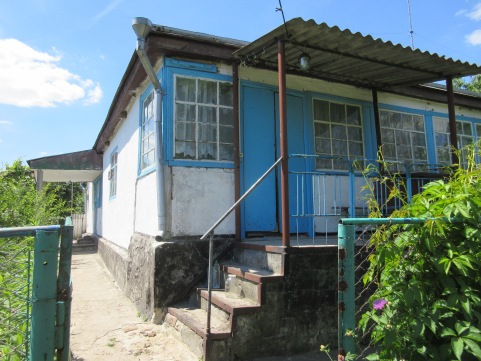
House still standing from shtetl times
We passed by the building, still original, that was the old yeshiva. These days, with expansions around it, it is a farm machinery repair shop. Further down the street was the old mikvah. The building that housed it is no longer there, the land it was on is overgrown with bushes.
Along the way, we visited some of the elders of the village, those born before the war. Though my great-grandparents left Yuzefpol over a century ago (they were already in Odessa by 1908, the year my grandmother was born), Valentina thought that maybe someone could have heard their last name mentioned through stories retold, or perhaps some Minsky relatives had remained and these elders had met them. Elder after elder we visited greeted us warmly and were eager to help, but could not recall ever having heard the last name Minsky. They, without specific prompting, recalled all the Jewish families they knew who were murdered by the Nazis. They said that the villagers who might have known anything about my great-grandparents have passed on, that I’m twenty or so years late in coming there. Sometimes knowledge and stories disappear with the people who hold them if we don’t capture those stories in time.
Our final stop for the day was the old Jewish cemetery. In an open field on a hill at the north-western edge of the village it stands. A cow, chained up in the field, greeted us at the entrance of the cemetery. Its chain had become wrapped around one of the few tombstones that’s still standing. Valentina patted the cow and unwrapped its chain from the tombstone. The cemetery is largely in decay, with most of the remaining tombstones laying in the ground, some halfway or more swallowed up by the Earth reclaiming them. Most of what remains of the cemetery are decaying foundations of tombs. Some of the surviving tombstones still have legible Yiddish/Hebrew writing on them. Knowing that with the hundreds, maybe thousands, that were buried here it would be highly unlikely, I couldn’t help but wonder if any of these might be my great-great-grandfather’s, Shulim Minsky, tombstone. I wondered if any other Minsky’s might be buried here. How many generations. How far back did we go in this village? Where did we come from before we came to this village? Maybe the answers, or at least a lead, were on one of those tombstones.
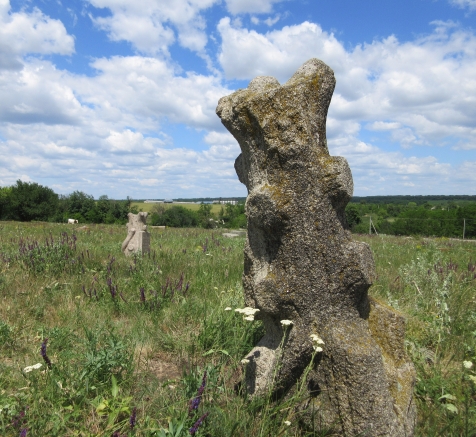
I pulled out a small stone with a heart-shaped colorful bead pattern affixed to its surface, which I remembered I was carrying in my backpack. It was gifted to me when I left Odessa, and I felt it had traveled with me for this very occasion. I placed it atop one of the tomb ruins in the center of the cemetery, to let the ancestors know there’s at least one descendant left of this old shtetl who honors their memory.
It was a bitter-sweet tour. My heart was swelling with both joy and sadness. Joy at the gift of the opportunity to connect with this land that my ancestors once dwelled upon. Grief over the deep sense of loss I felt walking around what, despite new residents living on the land, is a ghost town of the culture my ancestors were a part of there. This has become a familiar feeling journeying through Ukraine.
Before Valentina and I parted ways, she told me to come back to her place Monday morning and that she would take me to the village council office to see if there are any archival documents that could be of any use. We also made plans to visit the Holocaust memorial at the site where the Nazis murdered the village’s Jews.
I went back to Vassiliy’s house. He was still at work. I grabbed my guitalele from the house and sat down with it in the yard. I breathed in the fresh air of this rural village far from the bustle of city and industry. From my heart, through my hands and vocal chords began to stir prayer songs. Modeh Ani, the Shema, B’Shem Hashem, the Baal Shem Tov’s Niggun. I sang them out. A pair of mourning doves flew over from the woods next to Vassily’s land and perched themselves atop a tree nearby. I sang through tears that began running down my cheeks. I felt the land listening, ears perked up, with a sense of nostalgia for words, prayers, melodies it hadn’t heard in decades. A quiet breath after I finished singing, the doves flew back in the direction from which they came.
I hadn’t known it at the time, but I later learned that Vassily’s land was part of the old shtetl. It was land Jews had lived on. Who knows, perhaps even my own ancestors. I had assumed Vassily’s land was outside of the shtetl. We hadn’t passed by it on our tour. But on Monday at the village council office, Valentina’s son-in-law, the current head of the council, showed me a map of the village. He showed me the extent of the territory of the old shtetl. He pointed out where the marketplace was, the synagogue, the yeshiva, the mikvah, the cemetery. He pointed to a spot within the territory and said, “that’s where you’re staying now.”
I was flabbergasted. “I’m staying where the old shtetl was?!”
“Yep.”
I wanted to cry in amazement at the providence that brought me to not only tour the old shtetl my great-grandparents were from, but to live in it, lay my head at night in it, work the land of it (I spent Sunday voluntarily working Vassily’s fields), and get to feel its soil between my fingers during the time I was there. Had I lived in my tent by the lake, I would not have been in it. Had Lesya or Valentina set me up at either of their places, I would not have been in it. Had the village council office still been open when I arrived in town, I might not have met Lesya in the store next door. But I met her and she set me up to stay with her son, who lived on the land of the old shtetl.
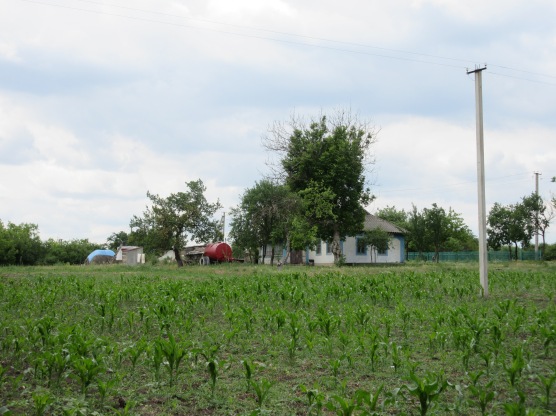
Vassily’s land and house
At the time I sung them, I thought that I had been singing those prayer songs on land not far from, but not exactly in, the territory of the old shtetl. I thought the land was listening from somewhere not far. Then I understood that it was the land I was on that had been listening to me. It was where I was staying that had been missing those old prayers, those old songs.
The village council office unfortunately held no archival documents of the Jews of old Yuzefpol. The head of the council said that if they still exist, they’re likely in the archives in Kirovograd, the administrative center of the oblast.
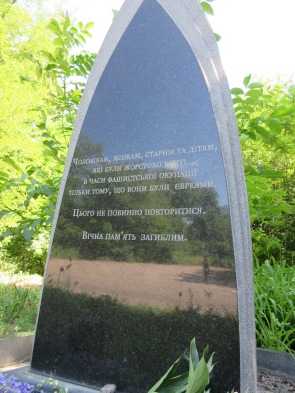
So here I am now. In Kirovograd. Digging further and further. On my way to Kirovograd, I stopped in Pervomaisk to find the man who organized the installation of the Holocaust memorial in Yosypivka/Yuzefpol, to see if he might have any info connected with my ancestors. Valentina, who was village council head when the memorial was installed, couldn’t remember his name and couldn’t find any documents with his name on it. There were no contact numbers for the Jewish community of Pervomaisk and no address as their community is small and they don’t have a synagogue or Jewish community center. All I had to go on was I was looking for a Jewish man in his 60’s or 70’s who helped build the memorial in Yosypivka/Yuzefpol a decade ago.
I found him. His name is Aleksander. Upon meeting him I felt a sense of comfort and warmth, like I was meeting with an old friend. I then learned that his grandparents were also from Yuzefpol. Unfortunately he didn’t recall them mentioning anything about any Minsky’s. Though they lived in Yuzefpol around the same time my great-grandparents were there. They probably knew each other. Perhaps they were friends. Perhaps that part of me that is my great-grandparents recognized the part of him that is his grandparents. Neither of us spoke it aloud, but I think that both of us were feeling, subtly somewhere in our bodies, in our chests, in our hearts, in the place our ancestors speak to us without words, like this was a reunion of sorts.
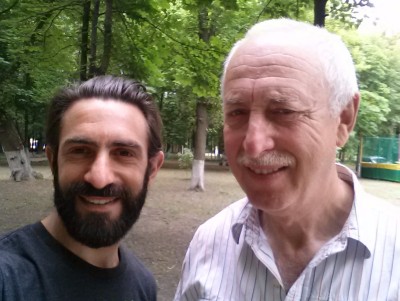
Soon I’ll be moving on to the other villages of my other great-grandparents. On to other reunions.
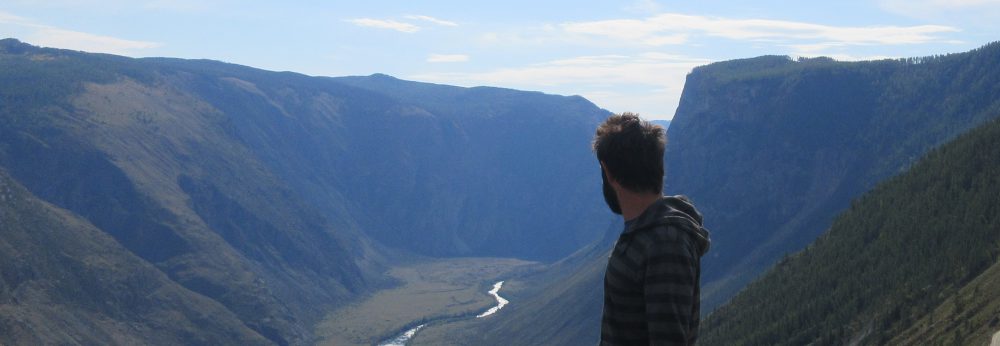
Google maps shows ten locations named Yosypivka, each in a different Ukrainian Oblast. Your account was fascinating, and gives me encouragement that I will, one day, be able to visit my own ancestral Ukrainian village.
LikeLike
Yes, there are many Yosypivka’s in Ukraine. There are even two in the Kirovogradska Oblast, where my great-grandparents came from. Luckily they have different historic names which helped confirm which one I was looking for.
LikeLike
What an amazing story…Thank you so much for sharing. Hope you write more about the other villages you visit.
LikeLike
Thank you Julie! I will.
LikeLike
It’s an interesting story. I also visited Ukraine looking for relatives of my grandfather who came to Canada in about 1913 from, what was then Ekatrinislav and is now Dniepro. I actually found a relative who was descended from my Grandfather’s family. Interestingly, he grew up in the house where my grandfather used to send money back to his family. He also had the same last name, Sandomirsky. He didn’t know the history of the house which I found strange. Even in his time the extended Sandomirsky family lived there. Unfortunately his parents had died several years before. He thought they might have known more than he did.
LikeLike
Amazing! What a blessing to find a relative! Thank you for sharing Carol.
LikeLike
Pingback: She Wanted to Build Bridges | Journey to the Lands of the Ancestors
Thank you brother for your words and tear and gifts to that land and the old ones.
LikeLike
It’s what I’m here for. Thank you brother for reading and receiving the story.
LikeLike
Pingback: Grief and Praise in the Old Shtetl of Zhmerynka | Journey to the Lands of the Ancestors
Pingback: Preserving and Reconciling History in Chernivtsi | Journey to the Lands of the Ancestors